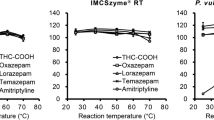Abstract
A method involving pyrolysis pretreatment followed by ion chromatography was developed to determine the residual thionyl chloride in levetiracetam. Levetiracetam was combusted at high temperature. After the pyrolysis gas was absorbed, the sulfur in thionyl chloride was converted to sulfate, which were determined by ion chromatography with conductivity detector using potassium hydroxide as the mobile phase. The linearity, limits of detection and quantification, and recovery of the method were evaluated. The average rate of conversion of thionyl chloride to sulfate was 98.2%, indicating good conversion efficiency. The limit of detection for sulfate was 8.85 μg/L. The relative standard deviation of the amount of SOCl2 calculated based on the concentration of sulfate was 2.70%, indicating good repeatability. The recovery for sulfate was 96.0–104%. The results suggest that pyrolysis combined with ion chromatography is an effective method to determine residual thionyl chloride in levetiracetam.




Similar content being viewed by others
References
Kasteleijn-NolstTrenite DG, Marescaux C, Stodieck S, Edelbroek PM, Oosting J (1996) Photosensitive epilepsy: a model to study the effects of antiepileptic drugs, evaluation of the piracetam analogue, levetiracetam. Epilepsy Res 25:225–230
Rhee SJ, Shin JW, Lee S, Moon J, Kim TJ, Jung KY, Park KI, Lee ST, Jung KH, Yu KS, Jang IJ, Chu K, Lee SK (2010) Population pharmacokinetics and dose-response relationship of levetiracetam in adult patients with epilepsy. Epilepsy Res 132:8–14
Sheinberg R, Heyman E, Dagan Z, Youngster I, Kohn E, Gandelman-Marton R, Berkovitch M (2010) Correlation between efficacy of levetiracetam and serum levelsamong children with refractory epilepsy. Pediatr Neurol 52:624–628
Patsalos PN (2000) Pharmacokinetic profile of levetiracetam: toward ideal characteristics. Pharmacol Ther 85:77–85
Sunees J, Marmon V, Differding E, Zimmermann V (2004) 2-Oxo-1-pyrrolidine derivatives, process for preparing them and their uses. US 6713635 B2, 2004–3–30
Wang HH, Wei YF, Chen WJ (2011) Optimization of synthesis of levetiracetam. Anhui Med Pharm J15:681-682,683 (In Chinese)
Ates C, Surtees J, Burteau AC, Marmon V, Cavoy E (2006) Oxopyrrolidine compounds, preparation of said compounds and their use in the manufacturing of levetiracetam and analogues. US 7122682 B2, 2006–10–17
Liu N, Huang CJ, Zhou HY (2007) Application of thionyl chloride in organic synthesis. Chin J Pharm 38:156–163 (In Chinese)
Bilenko NS, Lisetskaya GS, Sinkevich SM, Borovikov A (1991) Rapid determination of thionyl chloride in the air of industrial premises. Gig Sanit 4:76
Lisetskaya GS, Kozeiko TA, Bilenko NS, Sinkevich SM, Plotnitskaya AN (1986) Determination of thionyl chloride in the air of industrial workplaces. Gig Sanit 4:64–66
Czerwinski W, Gromotowicz W (1990) Determination of impurities in thionyl chloride by gasChromatography. J Chromatogr A 520:163–168
Hu JF, Zou M (2003) Thedetermintion of thionylthloride by gas chromalography. Jiangxi Chem Ind 4:143–145 (In Chinese)
Li JY, Li J, Li H (2016) Determination of thionyl chloride by gas chromatography/mass spectrometry. Chin J Forensic Med 31:81–82 (In Chinese)
Pereira JSF, Diehl LO, Duarte FA, Santos MFP, Guimarães RCL, Dressler VL, Flores EM (2008) Chloride determination by ion chromatography in petroleum coke after digestion by microwave-induced combustion. J Chromatogr A 1213:249–252
Buldini PL, Ferri D, Sharma JL (1997) Determination of some inorganic species in edible vegetable oils and fats by ion chromatography. J Chromatogr A 89:549–555
Buldini PL, Cavalli S, Mevoli A, Sharma JL (2001) Ion Chromatography and voltammetric determination of heavy and transition metals in honey. Food Chem 73:487–495
Dugo G, Pellicano TM, Pera L, Turco VL, Tamborrino A, Clodoveo ML (2007) Determination of inorganic anions in commercial seed oils and in virgin olive oils produced from de-stoned olives and traditional extraction methods, using suppressed ion exchange chromatography (IEC). Food Chem 102:599–605
Park Y, Kim Y, Lee DW, Lee S, Lee K (2002) Ion chromatographic determination method for the determination of inorganic anions in environmental samples of Korea. Anal Sci 18:343–346
Lopez-Moreno C, Viera I, Urbano AM (2010) Validation of an ion chromatographic method for the quantification of anions in water. Desalination 261:111–116
Wagner A, Raue B, Brauch HJ, Worch E, Lange FT (2013) Determination of adsorbable organic fluorine from aqueous environmental samples by adsorption to polystyrene-divinylbenzene based activated carbon and combustion ion chromatography. J Chromatogr A1295:82–89
Miyake Y, Kato M, Urano K (2007) A method for measuring semi- and non-volatile organic halogens by combustion ion chromatography. J Chromatogr A 1139:63–69
Miyake Y, Yamashita N, So MK, Rostkowski P, Taniyasu S, Lam PK, Kannan K (2007) Determination of trace levels of total fluorine in water using combustion ion chromatography for fluorine: a mass balance approach to determine individual perfluorinated chemicals in water. J Chromatogr A 1143:98–104
Miyake Y, Yamashita N, So MK, Rostkowski P, Taniyasu S, Lam PK, Kannan K (2007) Trace analysis of total fluorine in human blood using combustion ion chromatography for fluorine: a mass balance approach for the determination of known and unknown organofluorinecompounds. J Chromatogr A1154:214–221
Acknowledgements
This work was supported by the Project of Shanghai Science and Technology Innovation Action Plan in China (NO. 19391902400).
Author information
Authors and Affiliations
Corresponding author
Ethics declarations
Conflict of Interest
The authors declare that they have no conflicts of interest.
Additional information
Publisher's Note
Springer Nature remains neutral with regard to jurisdictional claims in published maps and institutional affiliations.
Rights and permissions
About this article
Cite this article
Luan, S., Liu, P., Zhang, F. et al. Efficient Determination of Trace Thionyl Chloride in the Antiepileptic Levetiracetam by Pyrolysis Combined with Ion Chromatography. Chromatographia 83, 1391–1395 (2020). https://doi.org/10.1007/s10337-020-03951-7
Received:
Revised:
Accepted:
Published:
Issue Date:
DOI: https://doi.org/10.1007/s10337-020-03951-7




